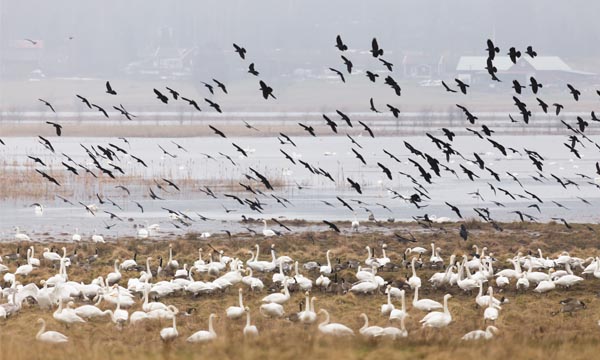Related Wildlife Species Founds in India
Lorem ipsum dolor sit amet, consectetuer commodo ligula eget dolor
Aenean massa Cum dis parturient montes.
Change language

Location :65-km from Dharamsala, Kangra District
Coverage area : 9,675-sq-km
Main attraction : Migratory Birds
Best time to visit :October-February
Nearby excursions : Dharamsala, Masrur
Nearby cities :Talwara
who love bird-watching and serenity, and want to spend some time alone in nature, Pong Dam Sanctuary is a retreat.
It welcomes them with its widespread beauty and fun-filled adventure sports. Let us get into the details.
Pong Dam is situated on the bank of Beas River, flowing in the upstream direction in Talwara district in the province of Himachal Pradesh. The main reason for the creation of the dam was to generate hydroelectricity and effectively run the land-water system. Afterward, the raised water-level made this a naturallake, whichgotits name after the incredible leader of Mewar, Maharana Pratap Sagar.
The claim to fame of this lake is that it is a haven for birds of various species including Red-necked Grebe and Bar-headed Geese. The impact was so huge that the whole lake was proclaimed as a Wildlife Sanctuary in the year 1986 by the Government of Himachal Pradesh. Other than giving a home to numerous birds and animals, Pong Dam additionally fills in as a vacation destination and a great place for water-sports. Activities likewater skiing and kayaking are arranged and operatedcommercially for water-sports lovers and tourists. The whole lake extends to a surface region of 240 square kilometers and during the rainy season, because of the accumulated rainwater, it reaches to a depth of 321 feet.
The climate of Pong Dam is tropicalin summer, which rises up to 45?C. During the rainstorms, the surface zone of the lake expands, and heavy rainfalltakes the water-level up. The normal rainfall estimated every year is around 1207 mm. Stormy seasons are observed between the long stretches of July and September. Generally, the winters are not so chillybutsometimes, when the temperaturegoes down to 5-6?C on the coldest days, it gets harder to derive any fun from the water, for the voyagers.
November to March is the best time to visit the Sanctuary, when the migratory birds come with their full force to the lake. Surveys portray that more than 1,00,000 waterfowls move to the lake during the chilly season every year and continue to increase in number as the time passes. Notwithstanding, in the summers, the travel industry is at its crest with water sports and on a yearly basis, national competitions arealso being arranged.
The lake is nourished by the Beas River and its various enduring tributaries areNeogal, Banganga, Gaj, Uhal, and Banner. The peaceful lake harbors around 22 types of fish, including uncommon fish like Gad and Sal. The satisfactory water dimension of the lake makes it a perfect place to enjoy water sports.
Migratory birds are in plenty here that make them hold their home throughout the winters and some of the summer months. Other than these birds, there are a few different types of reptiles and vertebrates that flourish in the rich biological community of the lake and its encompassing regions. The types of creatures found in the locale are recorded below:
Dharamshala, 78 km
Amritsar, 172 km
Chandigarh, 246 km
Karnal, 358 km
Dehradun, 393 km
Delhi, 490 km
Mumbai, 1857 km
Pune, 1910 km
Kolkata, 1942 km
Bangalore, 2610 km
Airways
Gaggal is the closest airplane terminal to Pong Dam andis around 40 km from the sanctuary. Other adjacent airplane terminals arein Jammu, Chandigarh, and Pathankot. Chandigarh air terminal is only 200 km from the place and is connected very well with the other major cities.
Railways
MukerianRailway Station is the closest railhead, which is 30 km away. One can likewise reach the spot by coming to Kangra Mandir Rail Station, which is at a distance of 22 km from the sanctuary. Since it is a little station, the majority of the trains do not stop here. Pathankot is the nearest junction, which is nearly about 32 km from the place. Pathankot is well-connected with all the significant urban communities in and around India.
Roadways
Kangra is only 8 km away from the sanctuary and is accessible from Pathankot, Masrur, and Nurpur. There are various transports especially for the tourists and plenty of state road corporation buses are also available that leave for PongDam. These buses are available on a daily basis. These transports originate from different urban cities including Delhi, Jammu, Chandigarh, and Dharamshala, on a regular basis.
Accommodation facilities
Pong Dam official tourism department has its own rest houses located inside the lake premises. There are also lodging facilities available in Dharamshala and Nagrota Surian, all through the year.